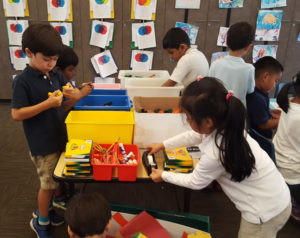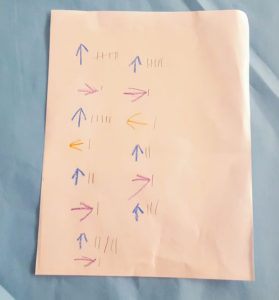
Right now my students are focusing on applying positional words to their everyday activities. Some examples of these words include: behind, in front of, above, below, next to, beside, in front of, and behind. Originally, I was thinking of having the kids recreate the story of Rosie’s Walk, but I wasn’t feeling the DOK 1 activity and knew my kids have way more creativity than to mimic a story. On my way to work one morning, I came up with a way better plan: have the kids work in groups to create their own story that includes a maze for the coding mice!
Materials and Set Up
As I mentioned, I came up with this idea on the way to work. Luckily the drive to work gave me enough time to think of what materials we would need and how things would get set up.
- Coding Mice – I have 3 sets of the coding mice that can be purchased on Amazon.
- Groups – Since I have 3 mice, I had three groups. My groups were larger than I like them to be (8-9 kids), but the kids managed. I randomly put my kiddos into groups.
- Butcher Paper – I figured the coding mice would have a hard time gliding over the division between our tables. With the butcher paper, the mice didn’t have too many problems. I taped the butcher paper down the middle and taped it to the table so it would stay still.
- Toys – this can seriously be anything: Tinker Toys, Legos, blocks, Lincoln Logs, pattern blocks, and scrap paper.
- Planning paper – This was regular printer paper.
- Rosie’s Walk – Pull out the book if you have it, if not here’s an online read aloud.

Stage 1 – Introduction
At the beginning of our day, we took care of some business and with 30 minutes until recess began and that was enough time to introduce the activity. I had the kids listen to the online read aloud and listen really closely for positional words. After, they called out words that they heard in the story. I wrote them on the board and drew mini images to accompany them. I asked the kids to tell me of other positional words they remembered from our previous activities that included these words. Our board looked like this:

Then I spilled the details to the activity to the kids and they were beyond excited. Here was the prompt:
Similar to Rosie’s Walk, you are going to come up with a story that has positional words. You will need to design a maze for the coding mouse to go through. With your group, you will need to complete these STEPS:
1. Come up with a setting together.
2. Choose a positional word to use in your story. Everyone needs to choose a different word.
3. Create something that goes with your positional word AND goes along with your group’s setting.
4. Code the mouse to go through the maze so it can get to the cheese!
It worked out perfectly that the kids had recess afterwards. Breaks are super beneficial, and I’m sure the front load of the plan was a lot of information to digest for the kids. They got a chance to refuel and came back from recess ready to work on the planning stage.
Stage 2 – Planning
Steps 1 and 2 were completed in this time frame. We have a 30 minute period after recess and before lunch, so this block of time for planning was perfect. Prior to heading out to recess, we discussed about strategies for working in groups.
- How can you figure out which setting everyone wants to work with?
- Around the table – Go around and have everyone give an idea.
- Vote – Which settings did the kids really like? Take a vote on those.
- What if someone wants your positional word?
- Decide if you can choose another word, or….
- …Rock, paper, scissors – Whoever wins gets the word!
After the groups came up with the settings, each kiddo put their transitional word on a piece of paper. They were supposed to sketch out their ideas on the paper, so that when they came in for lunch, they were ready to roll and create!

Stage 3 – Creating and Coding
Since having 26 kids mob a supply table would be a bit much, I sat the kids down on the carpet after lunch and had a “productive stalling period.” The settings my kids chose were: Legoland, the beach, and the farm. I knew some of my kids had not been to some of those places. I took a few minutes to do quick Google image searches of the various settings for the kids so they can get some ideas. After I finished one group’s image search, I released them to the supply table, and did the same thing with the other groups. I enjoyed watching their creations from scratch and how they used their imagination.

It was interesting to observe their strategies for figuring out the coding component. At the end of the day, I had the groups come together and shared what strategies they had tried. A whole class brainstorm took place on ways of keeping track of the code. Then came the idea of using tallies! The kids needed the morning of the next day to finish their codes with the tally idea.

Insight and Reflection
Considering this idea was super spontaneous, I think things went fairly well. The breaks throughout the day were helpful. I wasn’t planning on having the activity taking two days, but you can’t rush the process! Kids need that time to create, think, problem solve, re-plan, etc. In the future, I will plan on this activity being two days, however I can’t really decide how the steps would be broken up. I would take the lead of the kids, kind of like how I did for this year’s group. The intro, planning, and creating can easily be done in a day, the kids need time to get the coding down.

The goal is to integrate meaningful and memorable learning experiences for the kids as often as I can. The kids practiced so many skills in this activity: collaboration, critical thinking, creativity, math (positional words and estimation with the code), and coding. I am extremely proud of my kids for their perseverance, collaborative work, and flexibility. With one of the groups, the mouse was going bonkers and not moving straight and would take a wide turn. That group was so determined to have that mouse stay on path! I recorded all of the groups and shared the videos with parents.
The more often our students have practice with collaborative work, coding, and creating, the better they will be with those skills. We need to embed skills like the 4 Cs in our lesson design, so students can practice these skills often.
